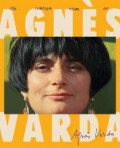| Reviews & Columns |
|
Reviews DVD TV on DVD Blu-ray 4K UHD International DVDs In Theaters Reviews by Studio Video Games Features Collector Series DVDs Easter Egg Database Interviews DVD Talk Radio Feature Articles Columns Anime Talk DVD Savant Horror DVDs The M.O.D. Squad Art House HD Talk Silent DVD
|
DVD Talk Forum |
|
|
| Resources |
|
DVD Price Search Customer Service #'s RCE Info Links |
|
Columns
|
|
|
Complete Films of Agnes Varda: Criterion Collection, The
The Collection:
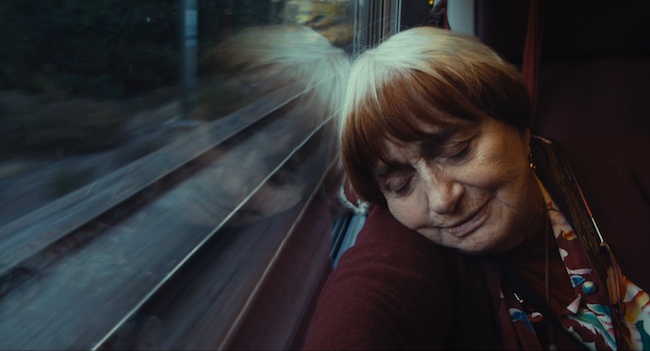
The Criterion Collection adds another great entry to its growing output of lavish box sets. In 2014, the company released The Essential Jacques Demy, highlighting the French filmmaker's best-known features. That excellent collection is now easily topped by Criterion's presentation of the work created by Demy's spouse, The Complete Films of Agnès Varda. Thirty-nine films are collected: shorts and features, fiction and documentary (with some bleed between those two distinctions, of course).
As Criterion did with their 2018 box set, Ingmar Bergman's Cinema, they have chosen not to present these films in strict chronological order. Instead, each of the set's 15 discs has a theme. As one progresses through all these discs, the connections between the films -- and not only those that have been included together -- become clearer. This makes Agnès Varda's output feel like one large, multi-part artwork. I feel like the many parts have been curated with care, so I will review the contents of the set in the presented disc order.
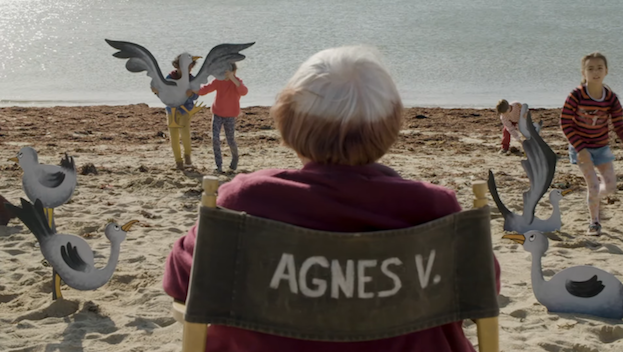
Disc 1: Agnès Forever
Quite appropriately, the set begins with Varda looking back over her body of work. The director's swan song, Varda by Agnès, premiered at the 2019 Berlin Film Festival, just barely a month before the 90-year-old legend passed away. Originally conceived as a master class, the film shows Varda addressing a number of different audiences as she tours through her creative output. This covers mostly film work, of course, but the second half of the documentary opens up a bit to include her early photographic work and later art installations. Varda avoids chronology, instead choosing to follow creative connections in her work that sometimes bounce back and forth across decades. Besides offering a valuable insight into Varda's creative process, Varda by Agnès is passionate and inspirational. Varda made her life her art and her art her life; creative people who view this film will feel energized and encouraged to do the same.
Also included is the 11-minute short, Les 3 Boutons (The 3 Buttons), from 2015. It is Varda's last fictional film, and it is a whimsical tale of a young teenage girl who works on a farm and muses about everyday magic and her own personal powers.
Both films are presented in AVC-encoded 1080p 1.85:1 transfers that look excellent. Some of the clips in Varda by Agnès are taken from SD video, so there are some to-be-expected inborn issues there. The feature is presented in French DTS-HD MA 5.1 surround, which offers some nice ambience in the rear, but the film is mostly driven by Varda's narration up front. The short features lossy French Dolby 2.0 stereo audio, which is suitable enough for this intimate adventure. Both films have optional English subtitles. There are a few stray English phrases in Varda by Agnès that are left unsubtitled.
Disc 1 Special Features:
(HD, 17:26) - The children of Agnès Varda talk about their life and film work with their mother. Rosalie, who is the spitting image of Agnès, also talks about guiding her mother's later projects to fruition.
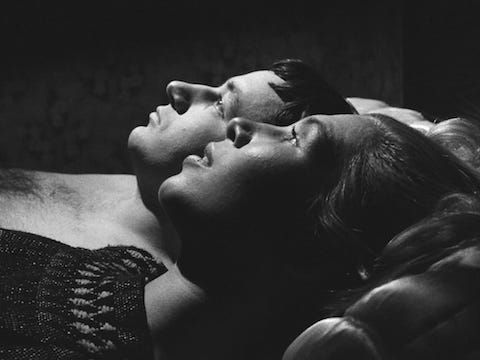
Disc 2: Early Varda
Here we have Varda's first film, the experimental feature La Pointe Courte (1955). Set in the titular fishing village, the film alternates between the ongoing travails and problems of the locals and the troubled romantic relationship of two visitors. There is intentionally no meaningful overlap between the two narrative threads, leaving room for viewers to muse about class and about the separation between communal life and private life. Varda also designs the two sections differently: village life is more naturalistic while private life is more formal, stylized, and alienating. Varda gets strong performances from both her non-professional actors and the couple played by Philippe Noiret and Silvia Monfort.
In the supplements, Varda talks about having trouble breaking into the film industry after La Pointe Courte. She took a few work-for-hire travelogue gigs in 1958 just to keep at it, and they are included here. O Saisons, O Châteaux (Oh seasons, oh castles) explores the castles in the Loire Valley. Since most of her subjects are giant stone edifices, Varda gets playful with her color camerawork and editing in a self-conscious way that absolutely must have had an impact on Wes Anderson's style -- and probably François Truffaut's along the way. The French Riviera doc Du Côté De La Côte (Coasting Along the Coast) is even more colorful and adopts a charming goofiness in its commentary and editing that is reminiscent of Bruce Brown's documentaries like The Endless Summer. In both of these, you can see Varda playing around with what she can smuggle stylistically into her assignments -- and some of the play is truly inspired. However, one can't help but feel a little antsy to see Varda making movies that are wholly her own.
All three films are presented in AVC-encoded 1080p 1.37:1 transfers that look excellent. La Pointe Courte has image flutter and a few density issues that are presumably irreparable flaws of the negative, due to the film's shooting conditions. The shorts are presented in richly saturated and well-delineated color. All the presentations are otherwise clean and stable. The feature is presented in French LPCM mono audio, while the shorts are left with lossy French Dolby Digital mono tracks. Some age-related narrowness on the main feature, but even with lower-res audio, the music-and-narration-driven shorts sound great. Optional English subtitles on all the films.
Disc 2 Special Features:
(HD, 8:59) - Actor-director Amalric discusses La Pointe Courte with Varda. Varda offers brief anecdotes about her writing process for the film, then discusses the pitfalls of being a first-time director with Amalric.
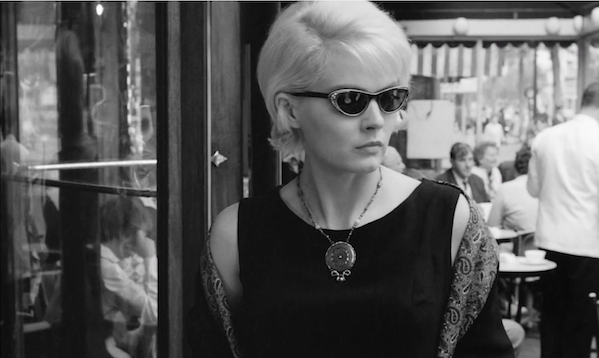
Disc 3: Around Paris
Cléo from 5 to 7 (1962) is probably Varda's best known film, and -- thanks to its Paris location shooting -- certainly the most "French New Wave"-y of her output. Corrine Marchand plays an up-and-coming young singer named Florence, nicknamed "Cléo" (short for "Cléopatra"), who is waiting on test results to learn if she has cancer. The film begins in color, with Cléo receiving a tarot reading that foretells her doom. She is abruptly returned to the "reality" of black-and-white and the streets of Paris, where she wrestles with her fate in real time. There's minor fudging of a few seconds here and there, but the film tries diligently to maintain strict chronology for 90 minutes. ("5 to 7" is French slang for... how you say?... "afternoon delight." So Varda -- ever-playful with words -- doubly frustrates literalists with this title, by doing a subject bait-and-switch [cancer in place of sex] and by cutting her scope down to "Cléo from 5 to 6:30.")
Varda divides the film in two. In the first half, Cléo remains wrapped-up in her self-centered pop star mindset. She cares most about how she looks and how she is perceived. In the second half, she begins to register more of what is happening in the world around her as she grows more empathetic toward others -- and herself. The films plays out as a series of encounters, divided up into explicitly timed chapters. The most charming might be Cléo's meeting with her songwriting team, including the film's composer Michel Legrand as a playfully irreverent version of himself. The youthful verve of Varda's storytelling merges surprisingly well with the existential searching of her main character, which suggests why the film remains resonant to this day.
Pardon the cliché, but Paris is arguably the main co-star of Cléo, so the film is complimented by other works that Varda made showing off Parisian architecture and design. The first is Les Fiancés du Pont MacDonald, set on the titular MacDonald Bridge. This is a very slightly longer cut of the silent-movie interlude featured within Cléo, when Cléo and her friend drop off some film to a projectionist then watch the screen from his booth. For her mock-silent comedy, Varda cast New Wave pals Jean-Luc Godard, Anna Karina, Eddie Constantine, Sammi Frey, and Jean-Claude Brialy. Included next is Varda's experimental musical documentary/fiction hybrid, L'Opéra-Mouffe (1958). She combines footage of the inhabitants of a skid row neighborhood with her own musings and fantasies about her first pregnancy, and then sets everything to music. In the accompanying interviews, she notes The Threepenny Opera as her influence, and Georges Delerue's songs have a strong Brecht/Weill flavor to them. Then we jump ahead to 1984's Les Dites Cariatides (The So-called Caryatids), in which Varda is commissioned to examine Paris's caryatids, an architectural feature in which pillars are sculpted in the shape of women. The style Varda utilizes falls perfectly in-between her early travelogues and her later docs, with Varda still designing some eye-grabbing shots and edits complimented by her idiosyncratic narration. The final film on the disc is a 1986 quickie, produced for the Cinemathèque Française, called T'as de Beaux Escaliers, Tu Sais (You've Got Beautiful Stairs, You Know). It juxtaposes shots of cinema patrons walking up and down the Cinemathèque's staircases with other shots of stairs from films.
Now lets get technical. Cléo and Beaux Escaliers are both presented in AVC-encoded 1080p 1.66:1 transfers, while the other shorts are presented at 1.37:1. Les Fiancés and Beaux Escaliers both look like they've been upscaled from SD sources, but the feature and other shorts all have had new restorations and scans that are crisp and satisfying. As with Disc 2, the feature is presented in French LPCM mono while the shorts are presented in lossy Dolby 2.0. No complaints. Optional English subtitles on all the films.
Disc 3 Special Features:
(HD upscale, 36:01) - Agnès Varda reflects on the making of Cléo in 2005 along with the cast and crew. They revisit locations and talk about the logistics of making the film, including making sure the geography and visible clocks all made sense for the real-time conceit. Varda and star Corinne Marchand talk about the themes and the main character.
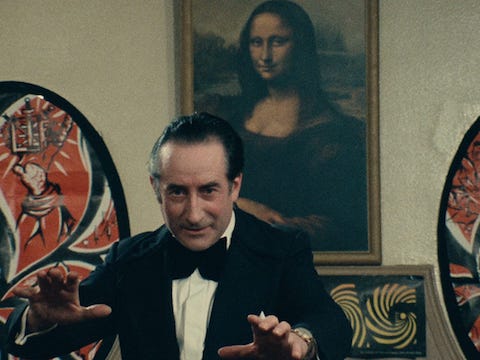
Disc 4: Rue Daguerre
Continuing through Paris, we zero in on the 14th Arrondissement, which was Agnès Varda's neighborhood for most of her life. In 1976, she produced the delightful documentary Daguerréotypes about the shop owners and street life near her home on Rue Daguerre. Louis Daguerre invented the early photographic process called the daguerreotype, so Varda's title is both a play on that and the word "stereotype" (which has accented "é"s in French). This suggests a somewhat auto-critical acknowledgment that Varda's fly-on-the-wall vignettes and the whimsical interview questions she poses to her neighbors create impressionistic caricatures rather than full-color portraits of each person's life. This doesn't prevent the film from making a deep impression. As we visit these often cramped shops, like a grocery run by recent immigrants or a perfume shop run by a frail elderly couple, we experience the small joys and deep sadness that come with banal everyday interactions and daily labor. In the film's second half, Varda interpolates footage from an illusionist's performance held in the local bar. These juxtapositions and rhyming images further underline the notion that the quotidian contains its own kind of magic.
There is also some magic to be found in the 2003 short Le Lion Volatil (The Vanishing Lion). Set in Place Denfert-Rochereau, this comic romance follows a psychic-in-training, played by Julie Depardieu. She falls for a guard at the Paris Catacombs who is fond of sleight-of-hand. This should be a tip-off, but Depardieu is soon shocked when both the man and the nearby Lion of Belfort statue both disappear without a trace.
Daguerréotypes is presented in an AVC-encoded 1080p 1.37:1 transfer, while Le Lion Volatil is presented at 1.85:1. Le Lion also looks like it is probably an upscale from SD, maybe because some coloring and visual effects in the short were finished on video rather than film or HD. Daguerréotypes meanwhile looks very good for a 16mm transfer; a little grainy but strong color and detail. The feature is presented with French LPCM mono audio while the short has a lossy Dolby 2.0 stereo mix. Optional English subtitles are available for both.
Disc 4 Special Features:
(HD upscale, 21:31) - Part update, part reminiscence, and part audio commentary over certain sequences from Daguerréotypes. There is also a great scene where Agnès reads some hate mail while getting her hair colored.
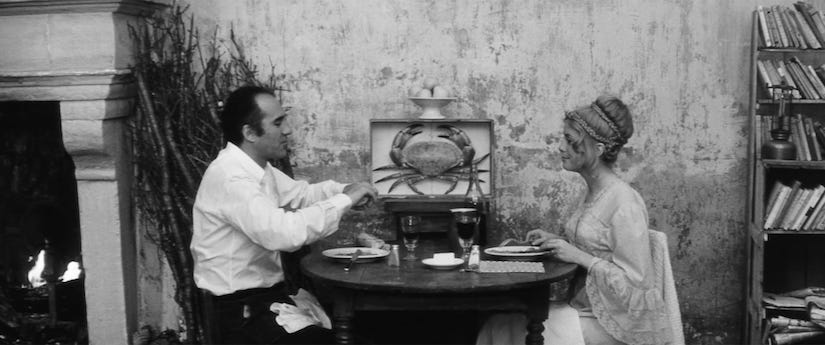
Disc 5: Married Life
Agnès Varda's third fiction feature is 1965's Le Bonheur (Happiness). It might be her most subversive and provocative work, thanks in part to how facile and pleasant it appears to be. Varda cast then-popular TV hero Jean-Claude Drouot as everyman carpenter François Chevalier, and she convinced Drouot's real-life wife, Claire, to play François's wife Thérèse. She also got the couple to feature their real children as the characters' young children. François and Thérèse are blissfully happy with their modest life and burgeoning family, so it seems odd when François starts seriously flirting with a sexy postal clerk named Émilie (Marie-France Boyer). When he starts a full-fledged affair with Émilie, François is totally upfront with her that he is having no trouble at home. François claims he simply wants to add happiness to his existing happiness. Viewers trained by traditional storytelling and centuries of melodramas will be waiting for the other shoe to drop or for everything to fall apart. Much to Varda's credit, that shoe does or doesn't drop -- depending on how you want to view the series of events that occur during the final act of the film. I could easily see different viewers look at Le Bonheur as a pro-polyamory fairy tale or as the slowest of slow-burn psychological horror films. Varda leaves us with ambiguity but not a cop-out, and that makes Le Bonheur the kind of film that burrows into your brain and refuses to give up its space.
Her follow-up feature, Les Créatures (1966), was a critical and financial failure upon release. But it has an unsettling energy akin to Le Bonheur that makes it hard to dismiss. That said, it's not as good as it could be. Varda's ambition is maybe a little too vast. This tale centers on a novelist and his traumatized wife, recovering from a car accident in a small village. Michel Piccoli plays the writer. His encounters with the locals take on a strange animosity, which starts to inspire his work. Catherine Deneuve is the wife, rendered mute after the accident. It's kind of a thankless part, especially without dialogue, but Deneuve makes her character naturally luminous. It's fun to see Eva Dahlbeck, who frequently worked with Ingmar Bergman in the '50s, as the proprietor of the local hotel. As the film develops, it takes more of a science-fiction turn and reveals its metafictional intent. The whole thing is an allegory for the creative process, you see. There's some fun to be had in determining if what we're seeing at any moment is supposed to be real or supposed to be part of Piccoli's developing novel. However, the most outlandish moments don't fully land because we already know they are just Piccoli's make-'em-ups. The stakes are diminished. It's not enough to sink the whole picture, which remains agreeably offbeat and brain-teasing.
The final film included on this disc is the short documentary Elsa La Rose (1966). The film is a portrait of the then-70-year-old writer Elsa Triolet, as filtered through the writing and poetry of her husband, the surrealist Louis Aragon. While Aragon idealizes his wife, Varda also talks with Elsa about her role as a muse and mentor to her husband. It's unsurprising that she doesn't like the way he puts her on an artistic pedestal, but their fondness and warmth is palpable even so.
Technically, each of the films is satisfyingly remastered, although the specs are all different. Le Bonheur is presented in an AVC-encoded 1080 1.66:1 transfer that features vivid color cinematography with saturated reds, bright sunflower yellows, and some strikingly cool blues. The audio is French LPCM mono, with optional English subtitles. Les Créatures comes in a black-and-white AVC-encoded 1080p 2.35:1 transfer. Varda's only 'scope film. Certain sequences feature pink and red tinting -- which can be a little hard to distinguish from each other (one is supposed to represent good, the other evil) -- but otherwise the contrast and clarity is good. The audio is French LPCM mono, with optional English subtitles. Elsa La Rose is sourced from black-and-white 16mm, with an AVC-encoded 1080p 1.37:1 transfer. There are some minor photographic issues due to the documentary style of shooting, but the restoration and transfer look accurate. The sound for the short is only lossy French Dolby mono with optional English subtitles.
Disc 5 Special Features:
(HD upscale, 3:01) - A 1998 intro for German TV. She talks about her inspiration for the film, and a young German boy helps translate some of it for the TV audience.
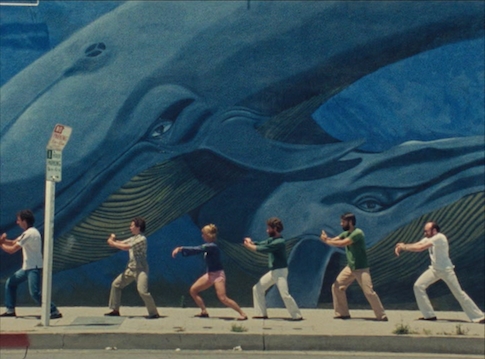
Disc 6: In California
The films included on this disc come from two different time periods: the late '60s and early '80s. During both of these periods, Agnès Varda was in Los Angeles to be near her husband, Jacques Demy, as he wrangled with Hollywood. (The first trip produced Model Shop while Demy's '80s project, a roller-skating Cinderella musical, was never made.) I reviewed these five films when Criterion released them as a DVD set in 2015, so I will defer to that older review. But, in a nutshell: California inspired Agnès to make concise and curiosity-driven documentaries like Uncle Yanco (1967), about a long-lost relative living in Sausalito; Black Panthers (1968), about the growing revolutionary movement; and Mur Murs (1980), which explores the world of Los Angeles mural art. At the same time, it inspired her to make messy and soul-searching fiction films: Lions Love (...and lies) (1969), featuring Viva from Andy Warhol's Factory and Hair creators Gerome Ragni and James Rado; and Documenteur (1981), a rumination on isolation and single motherhood.
In general, these films do look and sound better than the DVD versions, although they are presumably sourced from the same restoration as the SD iterations. Because this is a lot of material to cram onto one disc, the encoding bitrates aren't as high as those for some of the other films in this set. Still, these five films all look good in motion. The documentaries -- Uncle Yanco, Black Panthers, and Mur Murs -- are all presented in AVC-encoded 1080p 1.37:1 transfers, while the fiction (or meta-fiction) films -- Lions Love and Documenteur -- are both framed 1.66:1. All five films feature LPCM mono audio options. For Uncle Yanco, Mur Murs, and Documenteur, these lossless tracks are in French with optional English subtitles. (Mur Murs has French narration and English-language interviews; the latter are left without subtitles.) These three films can also be watched with lossy English Dolby mono dubs that are generally less pleasing than the original audio. Black Panthers and Lions Love are presented in English with optional English SDH.
Disc 6 Special Features:
(HD upscale 5:37 total)
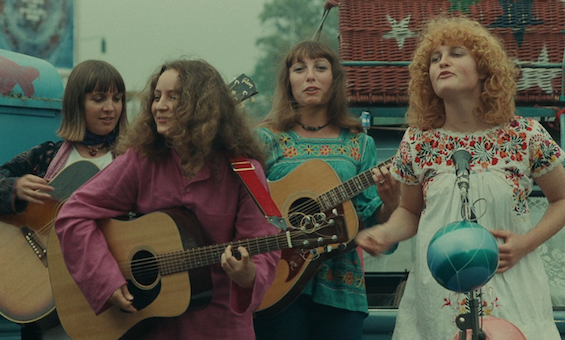
Disc 7: Her Body, Herself
The films on this disc were released as a stand-alone Blu-ray just last year, so I will defer to my review from 2019. However, there are a few more bonuses on this disc, so take a look even if you are familiar with the existing release. In brief: the 1977 feature One Sings, the Other Doesn't is an intimate epic that traces two women through a decade and a half of feminist uprising in France. The short Plaisir d'Amour en Iran (The Pleasure of Love In Iran) is a side story created from deleted One Sings footage. The 1975 documentary short Réponse de Femmes (Women Respond) surveys various women about their womanhood.
The films look and sound as good as they did on last year's Blu-ray. Maybe they sound even better, because I think the shorts might have had lossy audio before. Either way, One Sings and Plaisir are both presented in strong AVC-encoded 1080p 1.66:1 transfers, while the intended-for-TV Réponse is framed at 1.33:1. All films have French LPCM mono audio mixes, with optional English subtitles.
Disc 7 Bonus Features:
(HD upscale, 1:38:25) - The workprint version of an unreleased 1970 TV film, concerning the aftermath of the military coup in Greece. Part documentary, part semi-autobiographical fiction, part Brechtian satire. It touches on a lot of the concerns -- socially, politically, and artistically -- of Agnès's California films from this era. The film elements were confiscated before completion, but arguably this could have stood as one of her best features had she been allowed to complete it. Also it's interesting to see a young and scruffy Gerard Depardieu as a bohemian asshole who rips off the main character.
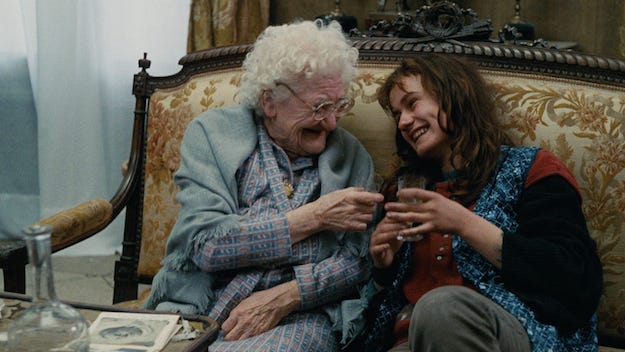
Disc 8: No Shelter
In 1985, Varda took an unsentimental but idiosyncratic look at the rarely explored world of female drifters. Vagabond (Sans toit ni loi, roughly: "Without shelter or law") begins with the haunting image of one such drifter, teenage Mona (Sandrine Bonnaire), as she is discovered dead in a ditch. The authorities rule it an accident and she is unceremoniously buried in a common grave -- from one ditch to another. Then, the film flashes back and chronicles the various interactions Mona had leading up to her death. Structurally, it seems like we are being led into a mystery story, but the bigger surprise might be how Mona survives for so long rather than how she ends. Played with the perfect mix of humanity and hardened nihilism, Bonnaire's Mona stays closed off from everyone around her. When she lets down her guard, she ends up rejected herself. The happiest moment comes when Mona finds her way into the home of a blind old woman and together they drink brandy and complain about the phonies all around them. Varda punctuates the film with talking-head testimony from characters who have encountered Mona and who have created a wide variety of impressions of who she is. Of course, none of them really know her. Varda offers no solution to her mystery of Mona, so by the film's end, we don't know her either.
Accompanying Vagabond is a surrealistic short from 1984. 7p., cuis., s. de b., ... (à saisir) (7rm., kitch., bath., ... (for sale)) is a fragmented look at a dysfunctional family whose experiences seem to haunt an empty house. The film was actually shot inside an art installation inside an old rest home, but Varda uses the surreal juxtaposition of the altered rooms (a bathroom covered in feathers, a kitchen covered in grass) to intensify her dream-logic ghost story. The film also includes appearances by Yolande Moreau and Marthe Jarias, who both found their way into Vagabond.
Both the feature and the short are presented in AVC-encoded 1080p 1.66:1 transfers. Because of its winter setting, Vagabond is relatively gray and sedate, but both films have nicely saturated colors. Vagabond is presented in a well-supported French LPCM mono mix, while the short film has a good but lossy Dolby mono mix. Optional English subtitles are available for both films.
Disc 8 Special Features:
(HD upscale, 40:37) - From 2003. A mixture of (then-)new interviews, revisits of film locations, and some archival clips.
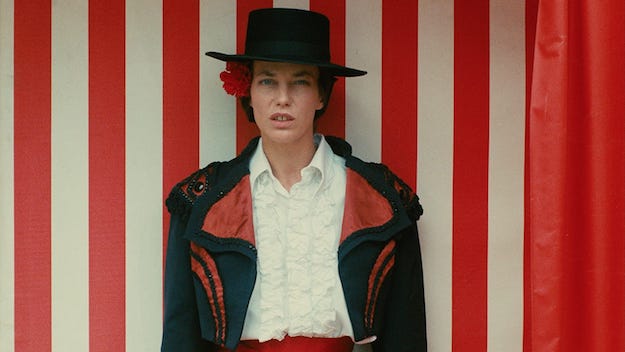
Disc 9: Jane B.
Model, actor, and singer Jane Birkin is often overshadowed by her former partner -- both romantically and musically -- Serge Gainsbourg. Gainsbourg shows up briefly in the portrait film Jane B. par Agnès V. (1988), coaching the uncertain Birkin in preparation for her first live concert. But that's mostly it. Varda seems instead more interesting in filling the Gainsbourg role herself in this film, guiding Birkin through artistic conceits and games. She puts Birkin in scenes that sometimes riff on their conversations and reflect moments from her life. She places her in living tableaux based on classic paintings. Varda frames her approach to this portrait as being the facilitator of creative concepts from Birkin, but there is clearly an element of Varda having fun scrutinizing and manipulating a willing model/subject. The end product is the ideal mixture of these two creative forces, transcending celebrity biography and experimental filmmaking to create a colorful moving sketchbook as personal as a shared diary.
The fiction film Kung-Fu Master! (1988), which grew out of the making of Jane B., also carries this feeling of a diary entry realized mostly for an audience of two. In Jane B., Birkin talks about giving Varda a short story she wrote a few years earlier. It involved a 40-year-old woman who fell in love with a 14-year-old boy. What might have served as fodder for another vignette in the Jane B. portrait collage metamorphosed into a full-fledged feature of its own. In fleshing out Birkin's story into a script, Varda tried to ground it in the reality of the world of 14-year-old boys. So, she made the object of affection obsessed with an arcade game called Kung-Fu Master. This film also became a kind of family project, as Varda's son Mathieu Demy was cast as the boy, and Birkin's daughters, Charlotte Gainsbourg and Lou Doillon (then ages 16 and 5 respectively), played the daughters of her character. The end result is both sensitively realized and terribly uncomfortable. Varda does not distance herself or viewers from the real-life stakes of such a situation, but she also finds a narrow path in which the plight of her characters is more touching than disgusting. Because of his childishness -- which is naturally part of the point -- I found the scenes with Demy's character less compelling than those between Birkin and Gainsbourg. For me, that mother-daughter strife is the key relationship in the film.
Technically, both films are sourced from the same restorations that Cinelicious put out on Blu-ray back in 2016. That release put each film on its own disc, so the bitrates were higher. These AVC-encoded 1080p 1.66:1 transfers do not suffer too much in comparison. The French (with English) LPCM mono audio sounds good on both films. The optional English subtitles are only available for the dialogue spoken in French.
Disc 9 Special Features:
(HD upscale, 4:13 total) - From 2012.
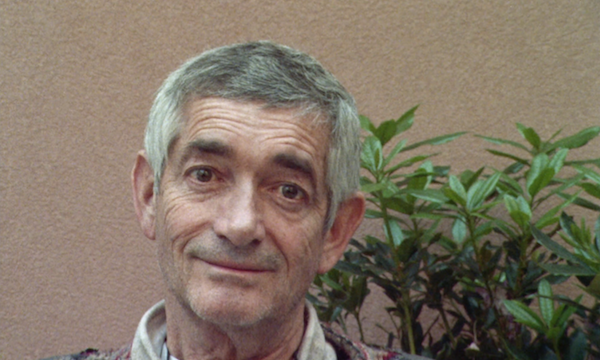
Disc 10: Jacques Demy
While cinephiles might think of Jacques Demy and Agnès Varda as a dream-team filmmaking couple, they typically kept their respective filmmaking ventures separate. When it became apparent that Jacques was dying of AIDS, Agnès suddenly turned her artistic focus to the life and career of her dying husband. 1991's Jacquot de Nantes (aka Jacquot in the U.S.) is mostly a fictionalized recreation of Demy's childhood, based on remembrances he began writing and sharing with Varda. She also incorporates intimate documentary moments of Jacques in his last days, including intense close-ups examining his gray hair and his sickness-spotted skin. The film is built on the idea that the strongest ideas for Jacques's work came from his childhood, so Agnès shoots her memory piece in many locations that appear in Jacques's films. She also includes excerpts of those films to show how these places and ideas resonated through the years. A scene of Catherine Deneuve as a hairdresser in A Slightly Pregnant Man counterpoints a scene of Jacques's mother running a hair salon out of their home.
The film also shows the burgeoning of Jacques's filmmaking. Young Jacques's attempt at a live-action short film fails when he screws up his camera's exposure, so he sneaks up into the attic to make stop-motion films where he can control every element. His father forces him into a technical school, to follow in the family business and become a mechanic. But despite the lack of support, and the ongoing tumult of World War II, Jacques finds his calling.
The two documentaries about Jacques that Agnès made around this time have previously appeared in Criterion's Essential Jacques Demy box as supplements. The Young Girls Turn 25 looks back at the making of Demy's The Young Girls of Rochefort. The small town of Rochefort organizes twenty-fifth anniversary events and an outdoor screening, inviting Agnès, Catherine Deneuve, and some others to attend. Agnès takes the opportunity to interview the locals who were involved in the film as extras. She also includes some behind-the-scenes footage she shot at the time. As a big fan of Demy's film, this is an invitation to delight in it all over again. Inevitably, there's an air of melancholy too, considering the death of Jacques and Catherine Deneuve's sister and costar Françoise Dorléac. One of the key moments from The Young Girls Turn 25 is Agnès's quiet observation and appreciation of a familiar image of Jacques putting on his sweater while directing. The second doc, The World of Jacques Demy, was expressively conceived as the nonfiction counterpoint to Jacquot de Nantes. It's a non-chronological exploration of Demy's film work that riffs on memories and intuition to connect the different projects together. Agnès interviews a number of Jacques's collaborators, but the most unexpected talking head is Harrison Ford, looking very much like Steven Spielberg. Ford explains how he was supposed to be the lead in Model Shop before the studio claimed he had no future in film.
Jacquot de Nantes and The World of Jacques Demy are both presented in great-looking AVC-encoded 1080p 1.66:1 transfers. The Young Girls is framed 1.37:1 with clips from the Demy film presented letterboxed within that frame. All films are presented in French LPCM mono with optional English subtitles. Bring sections in English are not subtitled.
Disc 10 Special Features:
(HD upscale, 17:05) - An interview with Agnès about the making of the film that also includes a new discussion with some of the core crew and the actors who played Jacques's parents.
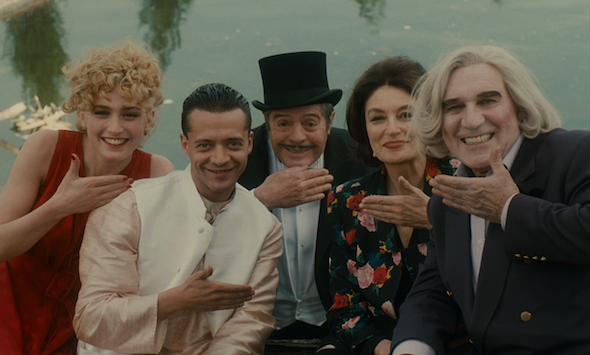
Disc 11: Simon Cinéma
In honor of cinema's 100th birthday, Agnès Varda made the relatively big-budget but utterly idiosyncratic love letter to the medium, One Hundred and One Nights (Les cent et une nuits de Simon Cinéma), in 1995. Michel Piccoli appears as Simon Cinéma, an old man possibly on the verge of death. Simon is a film buff and former film impresario whose resume and legend is ever-mutating depending on whomever he talks to. In a way, Simon is a physical embodiment of the movies, slightly enfeebled at 100 years old and dogged by a spotty memory and frequent hallucinations (often of film pioneers the Lumière brothers, punningly outfitted in suits of lights). He hires young film studies student and Madonna lookalike Julie Gayet to visit his memorabilia-stuffed mansion for 101 nights to talk to him about movies, so she'll spark his memory and make him happy. During this time, Simon is visited by a star-studded cavalcade of friends, including Marcello Mastroianni, Anouk Aimée, Gerard Depardieu, Alain Delon, Catherine Deneuve, Sandrine Bonnaire, Jean-Paul Belmondo, Gina Lollobrigida, Jeanne Moreau, Hanna Schygulla, and... Stephen Dorff? Robert De Niro also briefly appears as a rival for Catherine Deneuve's affections.
Agnès throws in a side-plot, in which Gayet's character attempts to swindle Simon out of his fortune to help pay for the Tarantino-esque short film of her boyfriend (Mathieu Demy), but mostly the film is surreal vignettes, assorted clips, and quippy dialogue about great (mostly French) movies. The tone is loopy, self-referential, and celebratory -- like a late-period Jean-Luc Godard film, but fun. (Of her New Wave pal JLG, Agnès has Simon Cinéma comment, "That Swiss guy talks like a book.")
Technically, One Hundred and One Nights looks and sounds real darn great. The AVC-encoded 1080p 1.66:1 transfer boasts rich colors and excellent clarity. The soundtrack is French LPCM 2.0 stereo with optional English subtitles.
Disc 11 Special Features:
(HD upscale, 8:38) - A brief piece in which Agnès reflects on her intentions for the film and for the character of Simon Cinéma. It includes some interview bits with Piccoli about the character.
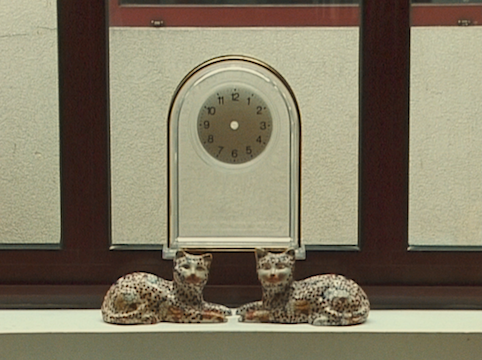
Disc 12: La Glaneuse
Digital video was all the rage in the late '90s and early '00s, taking the place that 16mm once held as the cheap filmmaking option for indie filmmakers. Agnès exploited MiniDV's ease of use to create a documentary that follows every tangential topical byway that her curious mind leads her down. The title of 2000's Les Glaneurs et La Glaneuse (changed to The Gleaners and I in English-speaking countries) refers to the people who glean food from the ground, left over after a harvest, and to Agnès the filmmaker, who gleans images with her portable camera. This idea of a cine-gleaner speaks to the looseness and openness with which she approaches the project. Many people who have shot with a camcorder know the annoyance that comes from realizing you've shot way too much footage of the ground or the lens cap because you forgot to pause the camera. Leave it to Agnès to turn the bobbing of her tethered lens cap as she unwittingly records the ground into a minute-long appreciation of the cap's "dance."
The film mostly profiles poor French citizens, who pick up potatoes rejected by the local farm or who scavenge the trash at farmer's markets. But from there, Agnès also investigates those who grab grapes to make wine for pleasure and those who scavenge ideologically, because they hate to see edible food go to waste. The film demonstrates that France has a long history of legal gleaning; Agnès even shows many instances where it is the subject of famous French paintings. Further connecting gleaning to art, she talks to creators of varying levels of prestige who use found objects in their visual art.
The Gleaners was a surprise worldwide success, so Agnès made a follow-up for the DVD release, The Gleaners and I: Two Years Later (2002). This film touches on the outpouring of mail and positive reactions toward The Gleaners. This inspires Agnès to visit some of the people who sent her mail. She also checks in with many of the people she talked to in the first film. Many of them had since seen the film. Most of them seem pleased, but one subject comments that he didn't enjoy Agnès's moments of reflection and self-examination, such as close-ups on her aging hands. Back in the early '00s, I was on this guy's side. I didn't understand the detour into what just seemed like home video footage of someone taking shots of themself with their new camera. Now, in the context of this box set, those moments play poignantly and further illustrate Agnès's multi-track mind.
As I said, both of these films originated on standard definition digital video, but they've been bumped up to AVC-encoded 1080p 1.33:1 presentations. Obviously there's a limit to how great these will look, but as with Criterion's recent Bamboozled Blu-ray, it looks like some effort has been made to pull more out of the image and polish it up. Two Years Later might even look a little bit better than the first film, but this might also have to do with the equipment used. The first film is presented in French LPCM 2.0 stereo, while the second is French LPCM mono. Both films have optional English subtitles. Because of the off-the-cuff nature of the filming, some of the sound is less-than-perfect, but in general, both films are well mixed and sound good in these lossless presentations.
Disc 12 Special Features:
(HD upscale, 0:43) - A short postscript.
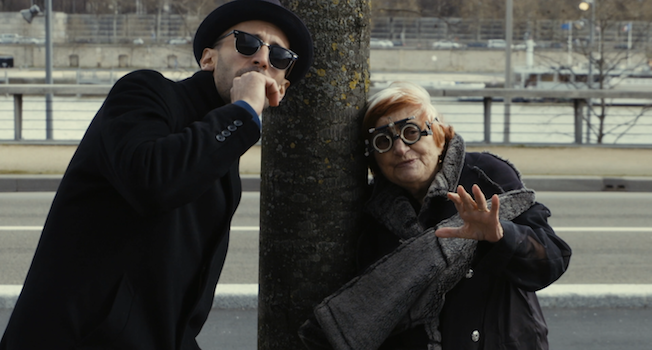
Disc 13: Visual Artist
At age 89, Agnès Varda became the oldest person nominated for a competitive Oscar. It was for 2017's Faces Places (Visages Villages), a collaborative documentary with street artist and photographer JR, who is fifty or so years her junior. Together, they go to different small villages and rural areas in search of people to meet and photograph. They drive around in JR's specially made truck that looks like a giant camera and has a photo booth inside. The truck also produces giant photo prints that can be used for pasting, which makes for great large-scale neighborhood group portraits. Agnès and JR seek to create installations that spring from the areas they are exploring. For example, in a mining town whose inhabitants are being evicted, they paste house-size images of miners who lived in the area decades before. At the home of one woman who refuses to leave, they turn her house into a giant defiant self-portrait. When the woman sees the enormous tribute, she starts crying.
Despite its simplicity -- or more probably, because of it -- Faces Places is intensely moving. The art fosters connections with all these people they (and we) meet, and it grows a deeper connection between Agnès and JR. Agnès is waylaid in a few moments by poor health and old age, but JR is supportive and compassionate. At one point, Agnès asks to meet JR's grandmother to figure out where gets his disposition from. She remains driven and indomitable throughout.
The disc includes three short films that were previously presented together as CineVardaPhoto. These shorts are also related to photography and explore, to varying degrees, the stories, the context, and the humanity represented by those images. The first chronologically is Salut Les Cubains (Hello, Cubans!), from 1964. This short is made almost entirely of stills shot in post-revolution Cuba, edited and sometimes animated in a style similar to Chris Marker's La Jetée. Agnès admits in her 2007 intro that the film's idealistic and optimistic narration about Cuba under Castro turned out to be short-sighted, but it's still a great collection of photography that has been inventively presented. The 1982 short Ulysse concerns a photo that Agnès shot in the '50s on the beach. In the image is a dead goat who likely fell off a nearby cliff, a naked man looking out to sea, and a naked young boy seated near the man and looking back at the goat. (This image is also referenced in Faces Places because they visit the beach where it was photographed.) Agnès reconnects with her models nearly three decades later and tries to piece together the shared meaning of the image. The final short from 2004, Ydessa, Les Ours, et Etc (Ydessa, The Bears, and Etc), focuses on an exhibit curated by Canadian artist Ydessa Hendeles. It consists of an overwhelming barrage of framed photographs from the early 20th Century of people with teddy bears. Agnès highlights several dozen of these photographs, unpacking different visual and historical themes, including World War II and the Holocaust. She also goes to Toronto to interview Ydessa Hendeles to discuss her work.
Faces Places just had a Blu-ray release two years ago, and it seems like an easy deduction that the AVC-encoded 1080p 1.85:1 presentation we have here comes from the same source. It still looks great, like you would hope an essentially new movie would. The soundtrack for Faces Places is French DTS-HD MA 5.1 surround (with optional English subtitles). The score by Matthieu Chedid gets some good play in the surround mix. Salut Les Cubains and Ulysse are framed at 1.66:1 and they come with lossy French Dolby mono audio mixes (both with optional English subtitles). They look great and sound just fine. Ydessa is framed at 1.37:1 and looks like an upscale from SD; the soundtrack is a lossy French and English Dolby stereo mix. No subtitles for the instances of English dialogue, the French is accompanied by a mix of optional and forced English subtitles.
Disc 13 Special Features:
(HD, 46:39) - A wonderful, lively English-language interview with Agnès and JR for the Cohen Film Collection release of Faces Places.
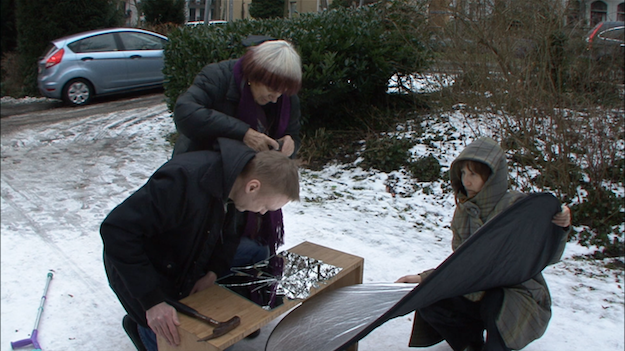
Disc 14: Here and There
Released in 2011, Agnes De Ci De Là Varda (Agnès Varda: From Here to There) is a 5-part TV series tracking Agnès's travels for roughly a year. She travels to promote The Beaches of Agnès (see Disc 15), to collect awards and attend retrospectives, and also to supervise art installations she devised. While it takes a little time to finds its rhythm, De Ci De Là is an agreeably art-centric travelogue that bounces around Europe, and North and South America. Agnès profiles artists and exhibitions, and she includes encounters with fellow filmmakers like Chris Marker (who only speaks off-camera), Carlos Reygadas, Manoel de Oliveira, and Alexander Sokurov. One charming vignette has her returning to La Pointe Courte to reconnect with some of the people who appeared in her first film.
Technically, Agnès De Ci De Là Varda looks like it was shot on a variety of digital cameras of varying quality, including Agnès's trusty DV camcorder. Overall, the AVC-encoded 1080p 1.78:1 presentation is pretty stable and consistent with just some inborn limitations of the format. The audio is lossy multilingual Dolby 5.1 surround, with optional English subtitles. No complaints. Again, the instances of spoken English are not subtitled.
No special features on Disc 14.
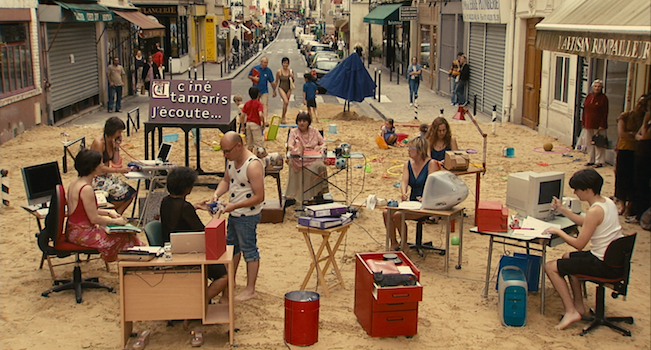
Disc 15: Beaches
The set wraps up as it began: with another look back. In this case, it's 2008's The Beaches of Agnès (Les plages d'Agnès). Anyone watching this set in disc order will be very familiar with the clips and stories that make up the majority of this self-portrait, but Agnès always seems to be engaging with her past and the images she has made from slightly different angles on each revisit. Compared to this set's opening bookend, Varda by Agnès, we are treated to a less work-focused rendering of Agnès's past. Memory, history, and emotion guide the narrative here. Also, some fun details surface that aren't touched upon elsewhere, like the use of a single 300-foot power cable to film all of Daguerréotypes -- meaning Agnès and her crew never traveled more than 300 feet from her home to shoot their footage.
Technically, Beaches comes in an AVC-encoded 1080p 1.85:1 presentation which appears to be sourced from another mix of digital cameras of differing quality. There are many film clips, but these are all sourced from older SD video copies (rather than "punching in" with more recent restored clips of the films). It also features a DTS-HD MA 5.1 surround mix that sounds good, but is heavy on narration in the front channels like most of these late-career docs.
Disc 15 Special Features:
(HD upscale, 1:12:07) - A collection of images and stories from Agnès's art installation, The Widows of Noirmoutier. A melancholy and moving exploration of loss and grief.
The Complete Films of Agnès Varda box set is also packaged with a generous 200-page paperback book that includes an introduction by Amy Taubin, stills, program notes by Michael Koresky, notes on the bonus features, the usual technical info, and essays by Ginette Vincendeau, So Mayer, Alexandra Hidalgo, and Rebecca Bengal.
Final Thoughts: Agnès Varda invested all of her films with a restless energy, the spirit of curiosity, and an uncompromising idiosyncrasy. Her early films challenge the norms of fiction and nonfiction filmmaking by picking and choosing elements from both modes and combining them in unexpected ways. Her more recent self-portraits and self-reflexive films are an even better showcase for Agnès's passionate and compassionate soul. When viewers see the films of Agnès Varda, they feel like they know her and wish they could have met her in person. She's inspiring as an artist -- and as a human. This beautifully presented and richly supplemented collection of Agnès Varda's complete cinematic work is an unparalleled triumph. DVD Talk Collector Series.
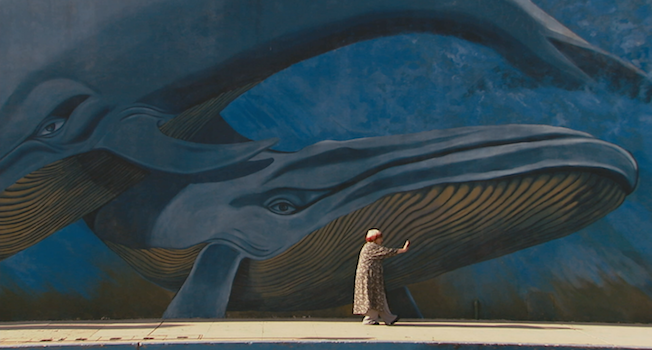
Justin Remer is a frequent wearer of beards. His new album of experimental ambient music, Joyce, is available on Bandcamp, Spotify, Apple, and wherever else fine music is enjoyed. He directed a folk-rock documentary called Making Lovers & Dollars, which is now streaming. He also can found be found online reading short stories and rambling about pop music.
|
| Popular Reviews |
| Sponsored Links |
|
|
| Sponsored Links |
|
|
| Release List | Reviews | Shop | Newsletter | Forum | DVD Giveaways | Blu-Ray | Advertise |
|
Copyright 2024 DVDTalk.com All Rights Reserved. Legal Info, Privacy Policy, Terms of Use,
Manage Preferences,
Your Privacy Choices | |||||||









